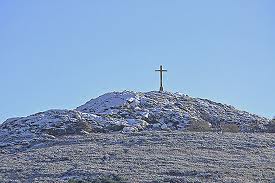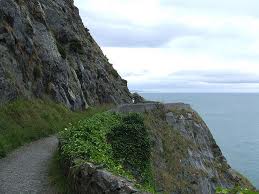
![]()
Index • |
Welcome • |
About
Us • |
21st Century • The Future |
World
Travel • Destinations |
Reviews • Books & Film |
Dreamscapes • Original Fiction |
Opinion
& Lifestyle • Politics & Living |
Film
Space • Movies in depth |
Kid's
Books • Reviews & stories |
Dreamscapes Two • More Original Fiction |
The International Writers Magazine: Ireland
How to walk up a hill in Ireland
• Marcel Krueger
I’m panting. My heart is racing, and feels like it will burst my chest any second. I need to stop. I take a deep breath that ends in slimy coughing, and snatch the water bottle from my rucksack for a deep gulp. “Come on! It’s only 150 metres or so to the summit!” I motivate myself.
Then I see the others following my trail: a grandmother with what looks like her two grandchildren, neither older than five. “..and after we climbed the hill, I’ll buy yis a 99!” is what I hear her say, before the group passes me and all of them throw a critical glance in my direction. If I ever felt like an idiot before, this definitively tops it.
I used to be an avid walker until about 6 months ago. Walking provided the only variety to my non-physical, desk-bound existence that I could agree with myself on. When it comes to physical activity, my motto has always been the one of Winston Churchill: “No sports!” But Ireland is a country that’s very suitable for walking, so putting on my walking shoes and strolling through the mountains and hills provided not only exercise, but also enabled me to discover the country(side) more and more.
Unfortunately for me, since the beginning of this year my time schedule has left no space for weekend excursions. But after a recent 3-week-stint in Iceland, where I mostly lived on hot dogs, beer and coffee and put on 3 kilos, I thought it to be a good idea to start walking again. For starters, I choose Bray Head with a height of 241 metres, a hill that I have climbed a couple of times in the past – it’s near the small coastal resort of Bray, next to the seafront with ice cream stands and a couple of welcoming pubs. And even more conveniently, I could reach Bray with the local commuter train (“DART”) directly from Dublin.
So I put on my trusted walking boots, a short but sturdy trouser and my new all-weather-jacket (courtesy of my stay in Iceland, where I hardly used it), packed a light lunch into my rucksack and boarded the train. Having arrived in Bray, I confidently strutted through all the flip-flopped families and Spanish teenagers that were enjoying a sunny afternoon while strolling along the seafront, feeling that my outdoor-equipment showed I meant business. No Sunday-afternoon laziness for me, this was about exercise and proving that man can conquer any obstacle nature puts in the way. From the seafront, the road snakes around the base of the hill, towards a car park and from there becomes a walking path that either leads up the hill or towards the base of the cliffs on the other side. But this was where I planned to return from my walk today, so I quickened my pace and started walking up the hill. The first 20 metres of the path are paved, but soon I found myself on a steep forest track that edges along the roots of trees and along small, dried-out creeks. I soon congratulated myself for choosing sturdy shoes. The sneakers of some of the people down at the seafront would have been torn to shreds by the blank stone edges that were protruding through the track everywhere. Not really, but the thought made me feel good at the time. I realised that the hill was somewhat steeper than I had remembered, and after passing another dried creek I had to stop and drink some water.
I saw that more people had thought the climb to be a good addition to their Sunday stroll, and had to choose more isolated parts of the track to continue my climb, to overtake the Sunday strollers and to hide my exhilarated state. I had started to sweat profusely, my face felt completely flushed and I was panting like a dachshund trying to make love to a greyhound. After the grandmother with her two grandchildren passed me, I finally gathered all the strength that was left and made the dash (or more the crawl) to the summit. There I was greeted by the sight of the tall concrete cross on the top of the hill (erected in the Holy Year 1950), picnicking Polish families, children playing with dogs and a clear vista over Killiney Bay towards Dalkey, Howth and even Malahide in the distance. Overwhelmed by the sights and my shaky legs, I sat down for a sandwich-and-water-lunch.Somehow, the added blood-circulation seemed to have made my muscles and joints remember what it was like to walk for a greater distance then from the front door to the off-license, so I set off with rediscovered energy, towards the town of Greystones south of Bray Head.
Walking along the top of the ridge, I soon was the only walker in sight. Most people return to Bray after climbing the hill, it seemed. From the cross my walk took me through an area filled with bushes and ferns and the occasional horse dropping, with the sea to the one side and the foothills of the Wicklow Mountains, especially the Great Sugarloaf, to the other.The only other mammals I met were a couple of horses grazing amongst the bushes, and those pretty much ignored my presence. Walking downhill to reach the track towards the cliff-walk and to complete my circular trip back to Bray, I encountered the one obstacle the walker always finds in the Irish countryside: a fence.
Most hiking trails in Ireland run across privately owned land, mostly farms, so you’ll encounter a fence or a gate sooner or later. Be prepared to climb over it. I was and did – and continued my hike down to a small road. I had followed the road for a couple of minutes, when I encountered another familiar obstacle: dogs. Two dogs of the large, black variety, with blood-shot eyes and huge fangs protruding from their jaws. For a moment the three of us stopped and faced each other in some kind of Mexican standoff. When you walk in Ireland, you normally encounter 2 types of dogs: the barking ones that protect their house (at which you can angrily wave your walking stick, should you happen to have one), and the friendly ones that come running towards you unexpectedly on some remote forest track. Not to devour you alive, but because they share the same appreciation for all humans alike. With these two, I wasn’t sure. Until their owner (unseen until then) shouted from behind some bushes: “They’re friendly!” which the two doggies used as an occasion to happily burst towards me, tails wagging. And I swear they were grinning when they jumped around me and tried to put their huge paws on my shoulder to lick my face.
After this very pleasant encounter I set off to finally complete my lap back to Bray, and after negotiating another fence and some slow pensioners on the trail, I soon reached the cliff walk that would lead me back to the start of my journey. From there on it was only a question of dodging the happy Sunday families that were coming in my direction and reaching the civilised part of the world again. Quite exhausted, dusty and sweaty I made it safely back to Bray. I was even strong enough to ignore the pubs along the street to the train station, and the cold beers on tap inside. This was about health, after all.
Altogether, I met:
- one granny and her grandchildren (critical)
- 5 grazing horses (indifferent)
- 2 dogs (friendly)
Duration:
Took me about 3 hours. Less if you are fitter than me. You can extend the walk by talking the cliff walk to Greystones and return to Bray from there, or even walk to the Great Sugarloaf and take a bus from Killmacanogue.
How to get there:
Bray is on the Dublin-Greystones DART-line. Start from Connolly, Tara Street or Pearse Street-station.
Bus number 45 will take you from Merrion Square to the DART-station in Bray.
KING OF PAIN
More travel
Marcel Krueger
www.kingofpain.org
www.twitter.com/kingofpain666
www.sonic-iceland.com
+353/86/7735523


